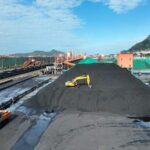Global Courant
The contemporary security context has exacerbated Japan’s dilemma regarding nuclear weapons.
Japan is surrounded by several nuclear-armed neighbors and relies on the comprehensive US deterrence rather than its own nuclear deterrent. An opportunity was embedded in Japan’s role as chairman of the G7 for the 2023 summit in Hiroshima, site of the 1945 nuclear attack and Prime Minister Fumio Kishida’s constituency.
The dilemma is one that Japan has faced for decades. In 1967, then Prime Minister Eisaku Sato introduced the Three Non-Nuclear Principles, adopted by the Diet, and declared that Japan will not possess, produce or introduce nuclear weapons.
In 1968, Sato reaffirmed this goal in his Four Pillars of Nuclear Policy, adding commitments to work toward global nuclear disarmament, the peaceful use of nuclear energy, and continued reliance on U.S. comprehensive deterrence.
Japan ratified the Non-Proliferation Treaty (NPT) in 1976 and the Comprehensive Nuclear Test Ban Treaty in 1997. Japan has consistently submitted draft resolutions in support of disarmament activities to the UN General Assembly and participated in programs such as the Non-Proliferation and Disarmament Initiative.
But the internal discussion continued. A range of senior politicians, including a former minister and deputy defense minister, and a prominent opposition leader, have expressed concern over Japan’s lack of its own nuclear deterrentespecially against China.
Former cabinet chief Yasuo Fukuda claimed that changing the Three Non-Nuclear Principles was “probable” after his deputy declared that possessing tactical nuclear weapons would be constitutional.
A nuclear-armed North Korea prompted similar comments. In 2006, after North Korea’s first nuclear test, Shoichi Nakagawa, chairman of the Liberal Democratic Party’s Policy Research Council, proposed a public debate on nuclear weapons acquisition.
In 2017, former Defense Secretary Shigeru Ishiba proposed hosting US nuclear weapons on Japanese soil, but was dismissed by the Defense Secretary at the time.
An intermediate-range missile target is launched from the Pacific Missile Range Facility in Kauai, Hawaii, during a test of a missile interception system. Japan is trying to strengthen its defenses against North Korea. Photo: US Navy via AFP/Latonja Martin
Despite its technical capabilities, Japan continued to shun acquisitions and instead relied on the nuclear umbrella of the United States. Japan’s security dilemmas have intensified recently, as leaders and the public observe heightened belligerence from its nuclear-armed neighbours.
North Korea’s recurring nuclear and missile tests in close proximity to Japan, along with direct verbal threats, sometimes require the evacuation of Japanese citizens.
In its aggressive nuclear rhetoric, President Vladimir Putin’s Russia resembles and has been North Korea peace negotiations suspended with Japan over Northern Territories. Japan also sees China’s “no borders” embrace of Putin and “wolf warrior” diplomacy as replacing China’s “peaceful rise”.
China’s military activities in the East and South China Seas and the firing of ballistic missiles in Japan’s exclusive economic zone have heightened tensions. Equally concerning is the fact that China is relinquishing its minimum nuclear deterrent capability of about 400 warheads. estimated to increase to 1,500 by 2035.
Putin’s nuclear rhetoric even prompted Chinese President Xi Jinping appeal to the international community to “jointly oppose the use of, or the threat of, the use of nuclear weapons.” Russian invasion of Ukraine reignited Japan’s concernswith former Prime Minister Shinzo Abe stimulating a national debate on nuclear weapons-sharing arrangements with the United States.
But Kishida, along with Defense Minister Nobuo Kishi, said such a scheme was “unacceptable given (Japan’s) stance to uphold the three non-nuclear principles.”
The sustainability of Japan’s commitment to adhering to the NPT is an important consideration. Some security analysts have predicted that Japan would seek its own nuclear deterrent in tandem with the nuclearization of three of its neighbors. Yet Japan’s decades-old nuclear abstinence defies those predictionsneglected other considerations.
Early in the Cold War, Japan’s commitment to global economic interdependence priority given to stability and access to the world market. This provided incentives to remain a non-nuclear-weapon state and reduce risks to its economy. Japan has also capped defense spending at 1% of GDP.
While by 2020 China had overtaken the United States Japan, as Japan’s main export market, still relied on the extensive deterrence of the US despite its own technological capabilities.
Unlike in South Korea, Japanese public opinion remains against the acquisition of nuclear weapons. a National survey 2019 found that 75% of respondents were in favor of ratifying the Treaty on the Prohibition of Nuclear Weapons.
To reassure the public, Japan’s leaders launched the largest military expansion since 1945. While Article 9 of the constitution famously renounced the right to maintain armed forces, the Diet voted in 2015 to allow Japanese troops abroad to to defend allies.
The 1% of GDP ceiling on defense spending was replaced in 2017 and Kishida in 2022 increased to 2% in 2027 — on track to become the world’s third largest defense budget. Joint military exercises have increased and Japan has signed new defense agreements with Australia and the United Kingdom.
Japanese Prime Minister Fumio Kishida rides a Japan Ground Self-Defense Force Type 10 tank during a review at JGSDF Camp Asaka in Tokyo on Nov. 27, 2021. Photo: JiJi
Japan also planned his G7 Presidency of the Hiroshima Summit carefully. Just like it championed the comprehensive and progressive Trans-Pacific Pcraftsmanship, Japan has sought leadership in other domains.
In 2022, Kishida founded the International Group of Eminent Persons for a World without Nuclear Weapons and became the first Japanese prime minister to attend the NPT Review Conference, where he presented the anti-nuclear “Hiroshima Action Plan”.
In early 2023, when Xi visited Putin in Moscow for three days, Kishida visited Kiev. He invited Ukrainian President Volodymyr Zelensky to attend the G7 summit, concerned about disturbing parallels between threats to Ukraine and threats in the Indo-Pacific.
from Kishida article in Foreign Affairs, published on the eve of the summit, expressed its commitment to strengthening “a free and open international order”. Reaffirming the principles of an April 2023 G7 communiquéKishida envisioned “a world without nuclear weapons”.
To set the tone, Kishida launched the G7 summit by greeting G7 leaders at the Hiroshima Peace Memorial Park. While the Hiroshima view on nuclear disarmament disappointed nuclear abolition, it also confirmed Japan’s longstanding abstinence from acquiring its own nuclear deterrent, even at this critical moment. Japan has stayed on course.
John T Deacon is a graduate student at the University of California, Irvine. Etel Solingen is the Distinguished Tierney Chair in Global Peace and Conflict at the University of California, Irvine.
This article was originally published by East Asia Forum and has been republished under a Creative Commons license.
Similar:
Loading…








